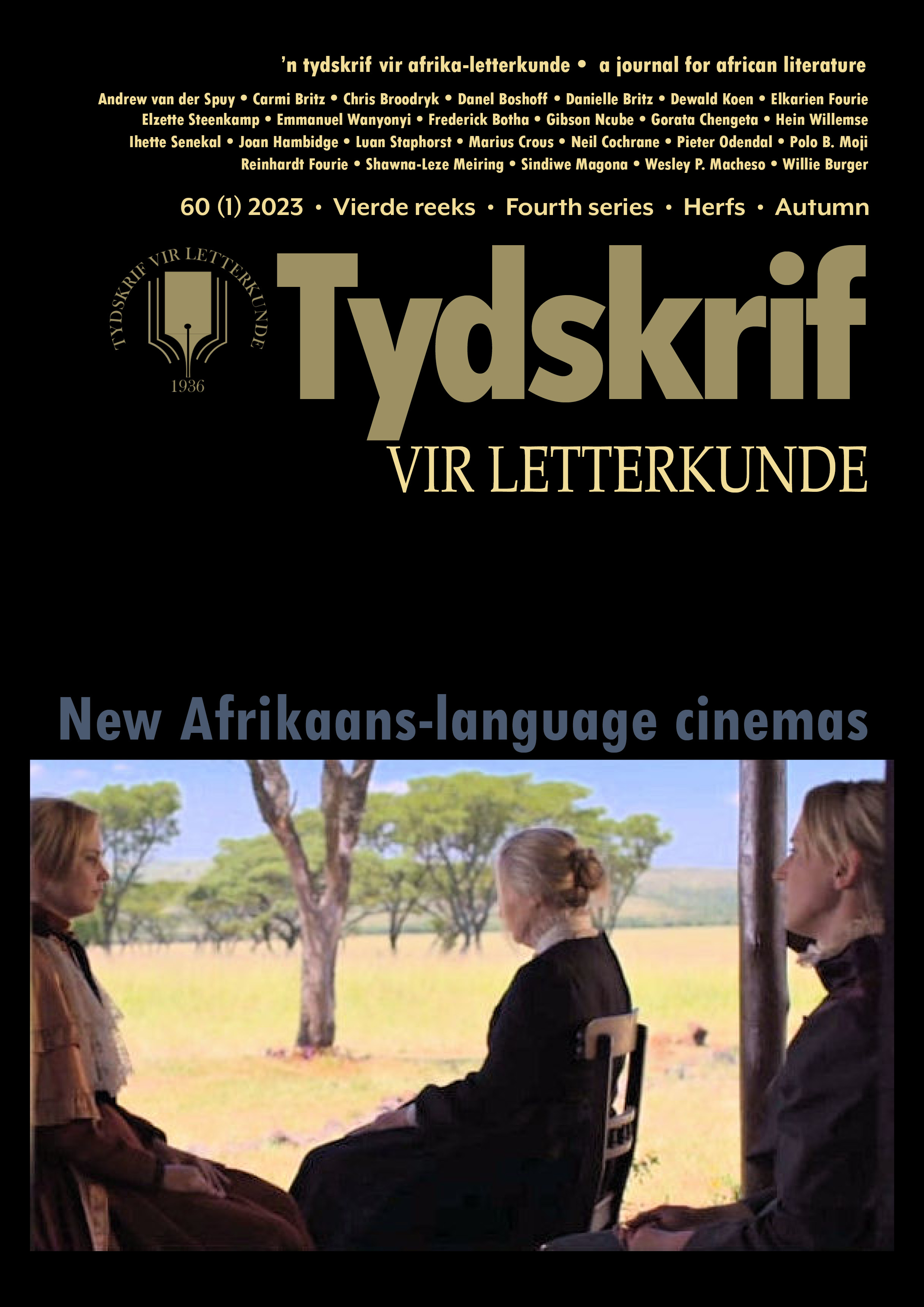Slow beauty: Refocusing Oliver Hermanus’s Skoonheid through a slow cinema lens
DOI:
https://doi.org/10.17159/tl.v60i1.15109Keywords:
Skoonheid, slow cinema, contemplation, alienation, narrative, slow imageAbstract
Oliver Hermanus’s Skoonheid is often read as a representation of South African queer realities and political progressiveness both during and since the dissolution of apartheid. Consequently, Hermanus’s contribution to the aesthetic of slowness in Skoonheid has gone largely unnoticed in the broader context of slow cinema. In this article, I examine how Hermanus, through the slow cinema conventions, urges the viewer to contemplate issues of crucial importance to human behaviour, thereby putting Skoonheid’s meditative qualities on display. Drawing on Ira Jaffe’s concept of expressive minimalism, Emre Çağlayan’s poetics of slow cinema, and Thomas Elsaesser’s observations on the virtues and demands of slow cinema, I analyse the narrative and aesthetic strategies deployed in Skoonheid within the purview of slow cinema and beyond a representation of queer sexuality. This analysis reveals that Skoonheid represents a mode of narrative-formal expressiveness distinct from, yet in dialogue with, slow cinema in its emphasis on contemplation. Principally, Hermanus finds a way to testify to some of the most urgent concerns in contemporary society through the film’s contemplative approach, which draws the viewer’s attention to the mystery and ambiguity of human experience. Skoonheid’s contemplative approach is informed by the film’s processes and experiences of alienation, incommunicability, and existentialism.
Downloads
References
Andrews, Grant. “The Boundaries of Desire and Intimacy in Post-apartheid South African Queer Film: Oliver Hermanus’s Skoonheid.” Image & Text vol. 31, no. 1, 2018, pp. 30–47. DOI: https://journals.co.za/doi/10.10520/EJC-106116ecae.
Bazin, Andre. What is Cinema? Vol. 1. U of California P, 2004.
Boczkowska, Kornelia. “Speeding Slowness: Neo-modern Contemplative and Sublime Cinema Aesthetics in Godfrey Reggio’s ‘Qatsi Trilogy’.” Art Inquiry vol. 18, 2016, pp. 221–53.
Bordwell, David. Narration in the Fiction Film. U of Wisconsin P, 1985.
Çağlayan, Emre. Poetics of Slow Cinema. Palgrave Macmillan, 2018.
Çağlayan, Emre. “Screening Boredom: The History and Aesthetics of Slow Cinema.” Diss. U Kent, 2014. https://kar.kent.ac.uk/43155/.
Cutting, James. E. & Ayse Candan. “Shot Durations, Shot Classes, and the Increased Pace of Popular Movies.” Projections vol. 9, no. 2, 2015, pp. 40–62. DOI: https://doi.org/10.3167/proj.2015.090204.
De Waal, Mandy. “Skoonheid—a film that confronts truths, both beautiful and ugly.” Daily Maverick. 24 Jul. 2011. https://www.dailymaverick.co.za/article/2011-07-24-skoonheid-a-film-that-confronts-truths-both-beautiful-and-ugly/.
Deleuze, Gilles. Cinema 2: The time-image. U of Minnesota P, 1989.
Doane, Mary. The Emergence of Cinematic Time: Modernity, Contingency, the Archive. Harvard U P, 2002.
Ebert, Roger. Roger Ebert’s Movie Yearbook 2007. McMeel, 2007.
Flanagan, Matthew. Slow Cinema: Temporality and Style in Contemporary Art and Experiemental Film. U of Exeter, 2012.
Ford, Hamish. Post-War Modernist Cinema and Philosophy: Confronting Negativity and Time. Palgrave Macmillan, 2012.
Goethe, Johann von. Elective Affinities, translated by Reginald Hollingdale. Penguin, 1978.
Gott, Michael. 2016. “The Slow Road to Europe: the Politics and Aesthetics of Stalled Mobility in ‘Heremakono’ and ‘Morgen’.” Slow Cinema: Traditions in World Cinema, edited by Tiago de Luca & Nuno Jorge. Edinburgh U P, 2016, pp. 299–311.
Gray, Chantelle. “The Spectre-image: A Hauntology of Skoonheid and Kanarie.” Image & Text vol. 35, no. 1, 2021, pp. 1–21. http://www.imageandtext.up.ac.za/imageandtext/article/view/242.
Grønstad, Asbjørn. “Slow Cinema and the Ethics of Duration.” Slow Cinema: Traditions in World Cinema, edited by Tiago de Luca & Nuno Jorge. Edinburgh U P, 2016, pp. 273–84.
Hermanus, Oliver. “Director’s note.” Skoonheid: Een film van Oliver Hermanus. Yumpu. 23 Feb. 2012. https://www.yumpu.com/en/document/read/19450509/skoonheid-cinemien.
Hermanus, Oliver. “Slow and Boring for Dummies.” Channel 24. 19 Aug. 2011. <https://m.channel24.co.za/Columnists/Oliver-Hermanus/Slow-and-Boring-for-Dummies-20110819>. Accessed 12 Aug. 2021.
Hermanus, Oliver & Olivier Barlet. “Oliver Hermanus: ‘It’s not a judgement of a character, it’s a portrait’.” Africine.org. 9 Jun. 2011. http://www.africine.org/entretien/oliver-hermanus-its-not-a-judgement-of-a-character-its-a-portrait/10237.
Hermanus, Oliver & Tymon Smith. “Directors chat: Oliver Hermanus.” Times Live. 5 Aug. 2011. https://www.timeslive.co.za/tshisa-live/tshisa-live/2011-08-05-directors-chat-oliver-hermanus/.
Jaffe, Ira. Slow movies: Countering the Cinema of Action. Columbia U P, 2014.
Jones, Tiffany. “Averting White Male (Ab)normality: Psychiatric Representations and Treatment of ‘Homosexuality’ in 1960s South Africa.” Journal of Southern African Studies vol. 34, no. 2, 2008, pp. 397–410. DOI: https://doi.org/10.1080/03057070802038058.
Kiss, Miklos & Steven Willemsen. Impossible Puzzle Films: A Cognitive Approach to Contemporary Complex Cinema. Edinburgh U P, 2017.
Kovács, András Bálint. Screening Modernism: European Art Cinema, 1950–1980. U of Chicago P, 2007.
Lockyer, Sharon. “Textual Analysis Methodologies.” The Sage Encyclopaedia of Qualitative Research Methods, edited by Lisa Given. Sage, 2008, pp. 865–6.
Lovatt, Philippa. “Slow Sounds: Duration, Audition and Labour in Liu Jiayin’s ‘Oxhide and Oxhide II.” Slow Cinema: Traditions in World Cinema, edited by Tiago de Luca & Nuno Jorge. Edinburgh U P, 2016, pp. 192–203.
De Luca, Tiago & Nuno Jorge. “Introduction: From Slow Cinema to Slow Cinemas.” Slow Cinema: Traditions in World Cinema, edited by Tiago de Luca & Nuno Jorge. Edinburgh U P, 2016, pp. 1–21.
Schoonover, Karl. “Wastrels of Time: Slow Cinema’s Labouring Body, the Political Spectator and the Queer.” Slow Cinema: Traditions in World Cinema, edited by Tiago de Luca & Nuno Jorge. Edinburgh U P, 2016, pp. 153–68.
Thomson, Claire. “The Slow Pulse of the Era: Carl Th. Dreyer’s Film Style.” Slow Cinema: Traditions in World Cinema, edited by Tiago de Luca & Nuno Jorge. Edinburgh U P, 2016, pp. 47–58.
Tomasulo, Frank P. & Jason Grant McKahan. “Sick Eros: The Politics of Antonioni’s Trilogy.” Projections vol. 3, no. 1, 2009, pp. 1–23. DOI: https://doi.org/10.3167/proj.2009.030102.
Warner, Rick. “Filming a miracle: Ordet, Silent Light, and the spirit of contemplative cinema.” Critical Quarterly vol. 57, no. 2, 2015, pp. 46–71. DOI: https://doi.org/10.1111/criq.12196.
Wildfeuer, Janina. Film Discourse Interpretation: Towards a New Paradigm for Multimodal Film Analysis. Routledge, 2013.
Downloads
Published
Issue
Section
License
Copyright (c) 2023 Tydskrif vir Letterkunde

This work is licensed under a Creative Commons Attribution-ShareAlike 4.0 International License.


 https://orcid.org/0000-0001-6465-6584
https://orcid.org/0000-0001-6465-6584


.png)